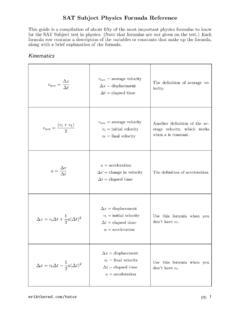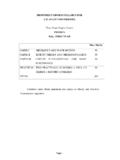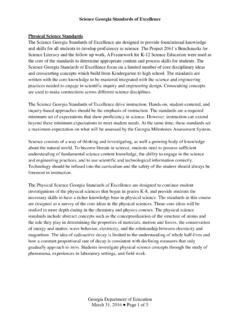Transcription of Organic Reactions andOrganic Reactions and Their ...
1 CHAPTER6 CHAPTER6 Organic Reactions andOrganic Reactions and Their MechanismsTheir Mechanisms6-1 SUBSTITUTIONREACTIONIn a substitution reaction, a functional group in a particular intermediateType of Organic substitutionintermediateNucleophilic AliphaticCarbocationAliphatic nucleophilic substitutionAromatic electrophilic substitutionElectrophilicAromaticCarbani onFree radical substitutionElectrophilicAromaticCarbani onFree radical The electrophilic and nucleophilic substitution Reactions are ofprime importance. Detailedunderstandingofareactiontypehelp stopredictthe2 Detailedunderstandingofareactiontypehelp stopredicttheproduct outcome in a reaction. It also is helpful for optimizing areaction with regard to variables such astemperatureand choice descriptionR L+ Nu: R Nu+ L: Nucleophilic substitution Reactions can carry out at asaturatedli h tibtthttdbtaliphaticcarbonor atotherunsaturatedcarboncentre.
2 Charge type:All necleophilesnecleophiles are Lewis bases. 3 Solvolysis: solvent used as a :nucleophilic substitution at an alkyl carbon. Acylation:nucleophilic substitution at an acyl carbon3 Acylation:nucleophilic substitution at an acyl NUCLEOPHILICSUBSTITUTIONMECHANISMS ATSATURATEDCARBONCENTRES Bimolecular Nucleophilic Substitution (SN2)Structure of the SN2 transition state The kinetic evidence: Rate = k [RX][Nu] Walden inversion:(+)-chlorosuccinic acid1wasconvertedto(+)1wasconvertedto(+) malic acid2by actionof Ag2O in water withretentionof4configuration, in thenext step theOHwasreplaced (1923)22223oooThere is a high probability that(a), (c), and (d) proceeded22owithretention, leaving(b)asthe ET AL. The negatively charged carbon attacks the methyl group ofanother molecule rather than the nearby one in the same molecule,that is, the reaction is intermolecular and not state in an SN2 reaction must be Unimolecular Nucleophilic Substitution (SN1) Unimolecular Nucleophilic Substitution (SN1)BrCH3HC+2 HOOHCH3HC+Br+HO+BrCH3H3C+2H2 OOHCH3H3C+Br+H3O+H3 CCH3 Reaction kinetics:rate = k [RX]Ionization of theBrH3CH3 CCH3CH3C+BrCH3HH3 CHIonization of the substrate is the rate-determinating +ClCH3CH3C+OHHH3CH3 COHH3 CHHH3 CSN1t-BuCl t-Bu++ Cl-630 kJ/mol (in gas phase)84 kJ/mol (in water)H3CH3CH3 COHHOHH+OHH3CH3CH3C+H3O+7 Salt effect and common-ion effect:An increase in ionic strength of thesolution usually increases the rate of an common ionwilldepress the Stericfactor.
3 ThereactionsrununderSN1conditionsfailor Stericfactor:ThereactionsrununderSN1cond itionsfailorproceed very slowly at the bridgehead position of [2,2,1](norbornyl)systems. Stereochemistry:Anexcessofinversionisusu allyobserved,as Stereochemistry:Anexcessofinversionisusu allyobserved,asthe leaving group can remain in proximity to the carbocationintermediate for a short time and block nucleophilic Ion Pairs in the SN1 Mechanism Ion Pairs in the SN1 Mechanismi. SN2 process:a complete inversionii. Intimate ion pair R+X : SRSRxSR+(1x)RStotal inversion if (a)does not take place or to a combination of SRSRxSR+(1-x)RSSHSN2SH(b)SHSR+RSRXR+XR+X inversion and racemizationif there is competition between (a)d(b)(a)R++XSRRSSHRXRXRXRXXR+XR+and (b).iii. Solvent-separated R+ X :more RSRSRS+(1)SRSHSN2 SHSHRXXRXRA complete picture of the possibilities forlliiltSH(iithracemization (perhaps total) iv.)
4 Free R+:complete RSRSxRS+(1-x)SRsolvolysisinasolventSH(ig noringthepossibilities of elimination or rearrangement).RS and SR represent enantiomers;x=some9pracemizationv. The difference: SN1 and SN2 mechanisms is SN2 mechanisms is in the timing of the steps. The Neighboring-Group MechanismOBSERVATION with certain rate ofreaction isgreater than expected,gp,ii. The configuration at a chiral carbon is retained and not inverted ihiiillfS2 Theneighboring-groupmechanismconsists essentiallyoftwoSN2substitutions, each causing an inversion so that the net result CBrCHMeO CHCOOH-CCHOHO10 O-Me MeOHMeO-EVIDENCE: (i)Configurational that bothproducts are optically()gppyinactive and so cannot be told apart by differences in rotation. Themesoanddldibromides have different boiling points and indexes +OHBrHCH3 BrBrHCH3 OHBrCH3 HBrBrCH3H++Br dl dl HCH3 BrBrCH3 HBrBr+BrHCH3 HCH3 BrHCH3 HCH3H+BrCCHHCH-H2O11 HCH3CH3 HOHCH3OH2CH3CH3Br-(2S,3S)(2S,3S)(2R,3S)( 2R,3R)(2S,3S)11(2S,3S)(2S,3S)CHHHCHHCHCH 3 HOHBrHCH3 OHBrHCH3 BrBrHBr+HCH3 OHBrCH3 HBrCH3H dl meso-H2 OBrHCH3 HBrCH3 BrCCCH3 HCH3 HOH2Br-HBrCH3 HCH312(2R,3S)(2S,3S)meso12(iii)Acetolysi sofboth4methoxypentylbrosylate1and5metho xy(iii)Acetolysisofboth4-methoxy-pentylb rosylate1and5-methoxy-2-pentyl brosylate2: the same mixture of products.
5 In this case theintermediate3is common to both Importantneighboringgroups:COO ,COOR,COAr,OCOR,OR,OH,13 Importantneighboringgroups:COO,COOR,COAr ,OCOR,OR,OH,O ,NH2,NHR,NR2,NHCOR,SH,SR,S , I, Br, Cl. The effectiveness: I > Br > OTsHOAcHOTsHOTsHAcO-AcOHk 10111 AcOH-TsO-AcO-ONBHONBHONBH+k H3CH3 CCH314k C. NUCLEOPHILICSUBSTITUTION AT ANALIPHATICTRIGONALCARBON. THETETRAHEDRALMECHANISMAcyl substitutionis basically a two-step nucleophilic addition andli i titiBthtitibltielimination steps are e tion+When Reactions are carried out in acid solution, thereXCRRCYX+YPreliminaryXCROH+H+XCROHOH CRXStep1there may also be a preliminary and afinalstepXCROHRCOHX+YYCR+XRCYXRCYStep1 Step2a final +XORRCOHXRCOHRCYYCR+H+pFinal15 RCOHYCRO+ FortheSN2mechanismbranchingateitherthe orthe carbonD.
6 Reactivity The Effect of Substrate Structure FortheSN2mechanism,branchingateitherthe orthe carbondecreases the 1. Average relative SN2 Primaryand secondaryTable 1. Average relative SN2 rates for some alkyl substratesRRelative tRRelative tyysubstrates generally react bythe SN2 mechanism andtertiary by the SN1 Elimination is always a possible side reaction of nucleophilicbfb(hhd)16substitutions oftertiary substrates(wherever ahydrogen is present). Sbt tfthtRCOX llhtith Substrates ofthetypeRCOXare usuallymuchmorereactivethanthe corresponding RCH2X. The mechanism here is always thetetrahedralone. explanation :i. The carbonyl carbon has a sizable partial positive bond must break in the rate-determiningstep, which requires more energy than the shift ofapairof electrons, which is what happens in atetrahedral carbon.
7 Unsturation at the 2. Relative rates for the SN1 reaction between ROTs and ethanol at 25 (CH3) ~ 105~1017CH2= ~ 1010 NOTENOTE In general,SN1 rates at allylic substrateare increased by anysubstituent in the 1 or 3 position that can stabilized the carbocationbhjtiAthlk lldbyresonance are alkyl,aryl,andhalo groups. SN2 rates for allylic and benzylic systems are also increased ( ), probably owing toresonance possibilities in the transitionstate. -Substitution resonanceeffect,fieldeffect Substitutionresonanceeffect,fieldeffectZ CH2 XSN1 relative rateZ = RO, RS or R2N-Very rapid,2ypZ = RCO, HCO, ROCO, NH2CO, NC, F3 CDecreased compared to toward SN1 and SN2 Reactions . (Z = RCO, HCO, ROCO,NC, or a similar group)S1iiS2iiSN1 reactivitySN2 reactivityAr3 CXRCHDXAr3 CXR3 CXAAAr2 CHXRCHDCH2X Ar2 CHXZCH2CH2 XROCH2X, RSCH2X, R2 NCH2XC=CX ArCH2XR3 CCH2XR2 NCH2XR3 CXZCH2X ZCH2XC=CXC=CCH2 XZCH2CH2XC=CCH2 XArXR2 CHXArXRCH2X ~ RCHDX ~ RCHDCHXB ridgehead-X19 RCHDCH2 XRCH2X ~ R3 CCH2X [2,2,1]bridgehead-XR2 CHX19 The Effect of the AttackingNucleophile SN1rate: areindependentof the identity of the nucleophile, sinceit does not appear in the rate-determining Effect of the Attacking Nucleophile ForSN2reactions in solution there are four principles that governthe effect of the nucleophile on the a negative charge > its conjugate nucleophilewith a negative charge > its conjugate acid.
8 OH > H2O, NH2 > comparing nucleophiles whose attacking atom is in the samerow ofthe periodic table,nucleophilicityis approximately in orderof >RO >OH >R2NH > ArO >NH3>C6H5N>F >H2O > ClO4 ;R3C >R2N >RO >F .24; down the periodic table,nucleophilicityincreases, thoughbasicity >Br >Cl >F (solvation, HSAB principle) freer the nucleophile, the greater the : The rate of nucleophilic attack by (EtOOC)2 CBu-Na+in benzene wasincreased bythe addition of1, ,y20 NOTE:NOTE:i. The four rules given above do not always hold. One reason isthat steric influences : Me3CO > OH or OEt Nucleophilicity: Me3CO < OH or OEt ii. Nucleophilicity order for SN2 mechanism (in protonic solvents):RS > Ar > I > CN > OH > N3 > Br > ArO > Cl > C6H5N > OAc>HO> OAc> For substitution at a carbonyl carbon, the nucleophilicity order isnotthesameasitisatasaturatedcarbon,but followsthenotthesameasitisatasaturatedca rbon,butfollowsthebasicity order more >MeO >OH >ArO >N3 >F >H2O>Br ~I 2121 TheEffectoftheLeavingGroup At a saturated leaving group comes off more Effect of the Leaving , andthe best leaving groups are the weakest bases.
9 Thusiodide is the best leaving group among the halides and fluoride , TosylatesROBspBromobenzenesulfonatesBros ylatesROSO2NO2 ROHp-Bromobenzenesulfonates,BrosylatesRO NsNiblfNl2222 ROSO2CH3 ROMsMethanesulfonates, Mesylatesp-Nitrobenzenesulfonates,Nosyla tes22 At a carbonyl the tetrahedral mechanism at a carbonylcarbon, the bond between the substrate and leaving group is , ,thenatureoftheleaving group still affects the reactivity in two greater the electron-withdrawing character of X,the greaterthe partial positive charge on carbonyl carbon and the more rapidthe attack by a oftheleaving group affectstheposition ofequilibrium. There is competition between X and Y as to whichgroupleave:gp23 RCOCl > RCOOCOR > RCOOAr > RCOOR >RCONH> RCOO-23 RCOCl > RCOOCOR > RCOOAr > RCOOR > RCONH2> RCOO.
10 The Effect of the Reaction MediumTable 3. Transition states for SN1 and for SN2 Reactions of the four charge typesReactants and transition Charge in the transition tt lti t t tiHow an increase in solvent p l rit ff t th r tstatesstate relative to starting materialspolarity affects the rateType a RX + Y Y .. DispersedSmall decreaseType b RX + Y Y +.. IncreasedLarge increaseType c RX++ Y Y .. +DecreasedLarge decreaseType d RX++ Y Y +.. +DispersedSmall decreaseRX R +..X +IncreasedLarge increase When there is a greater charge inthe transition state than in thestartingcompoundthemorepolarthesolven tthefasterthereactionRX+ R +..X +DispersedSmall decreasestartingcompound,themorepolarthe solvent,thefasterthereaction. Even for solvents with about the same polarity, there is a differencebetween protonic and aprotonic solvents.




